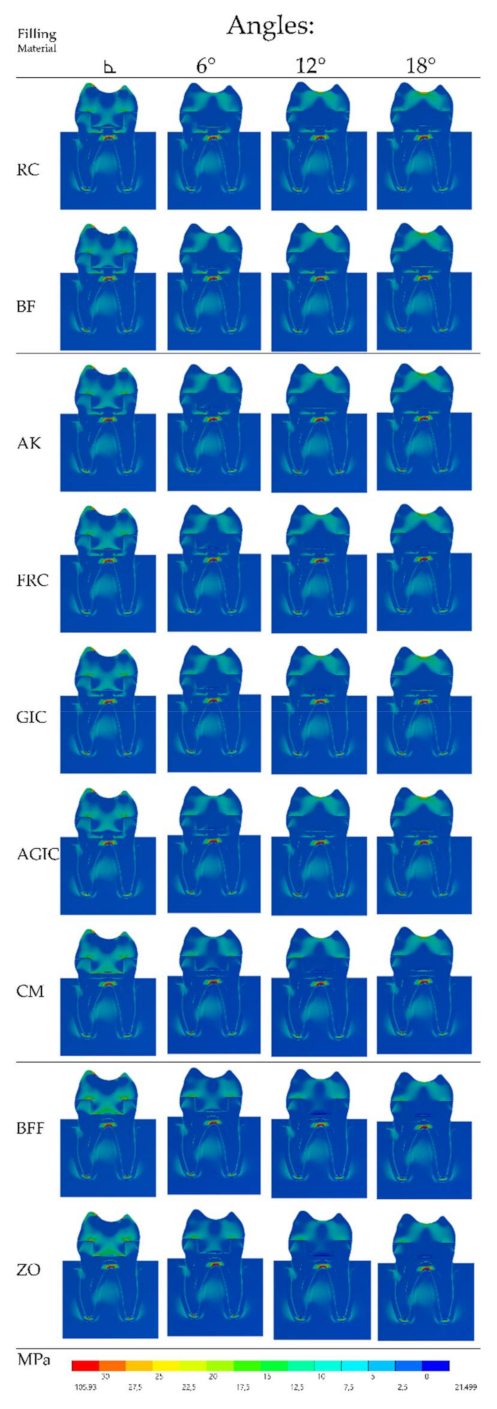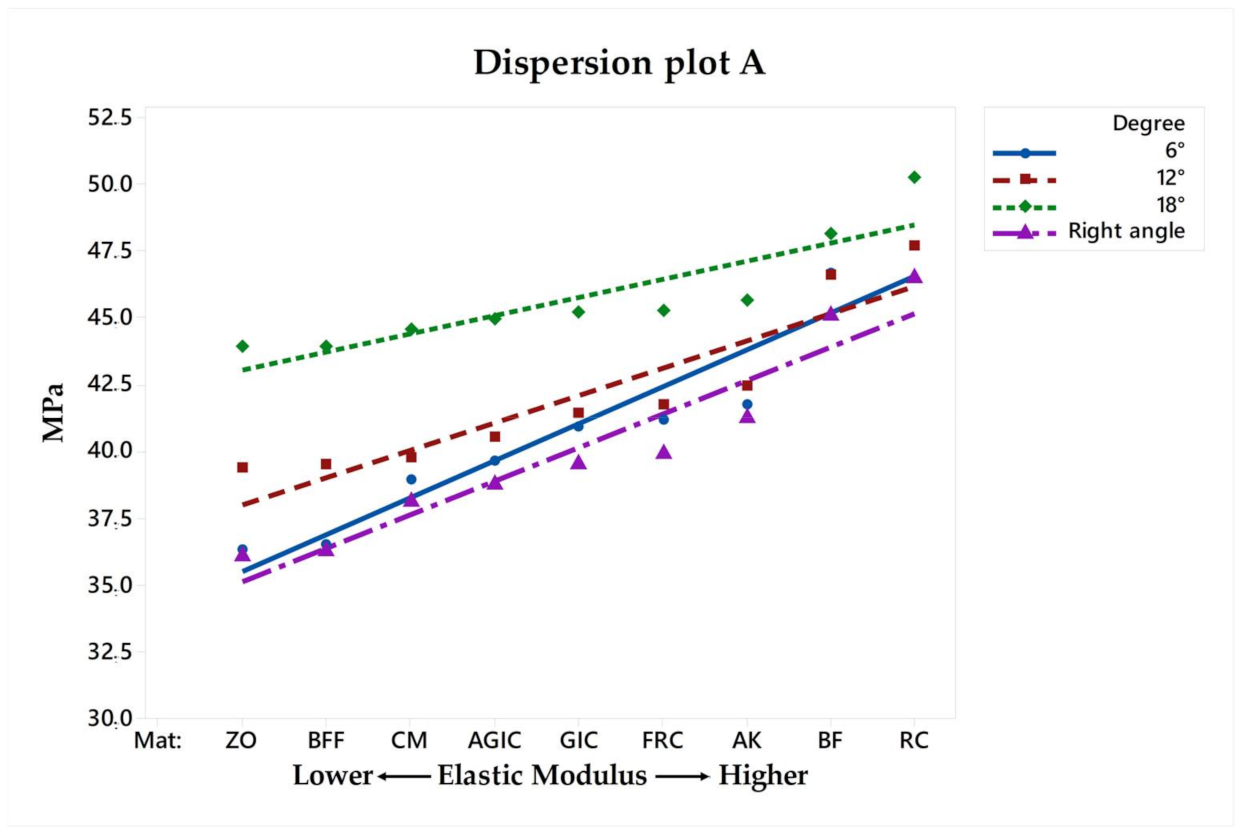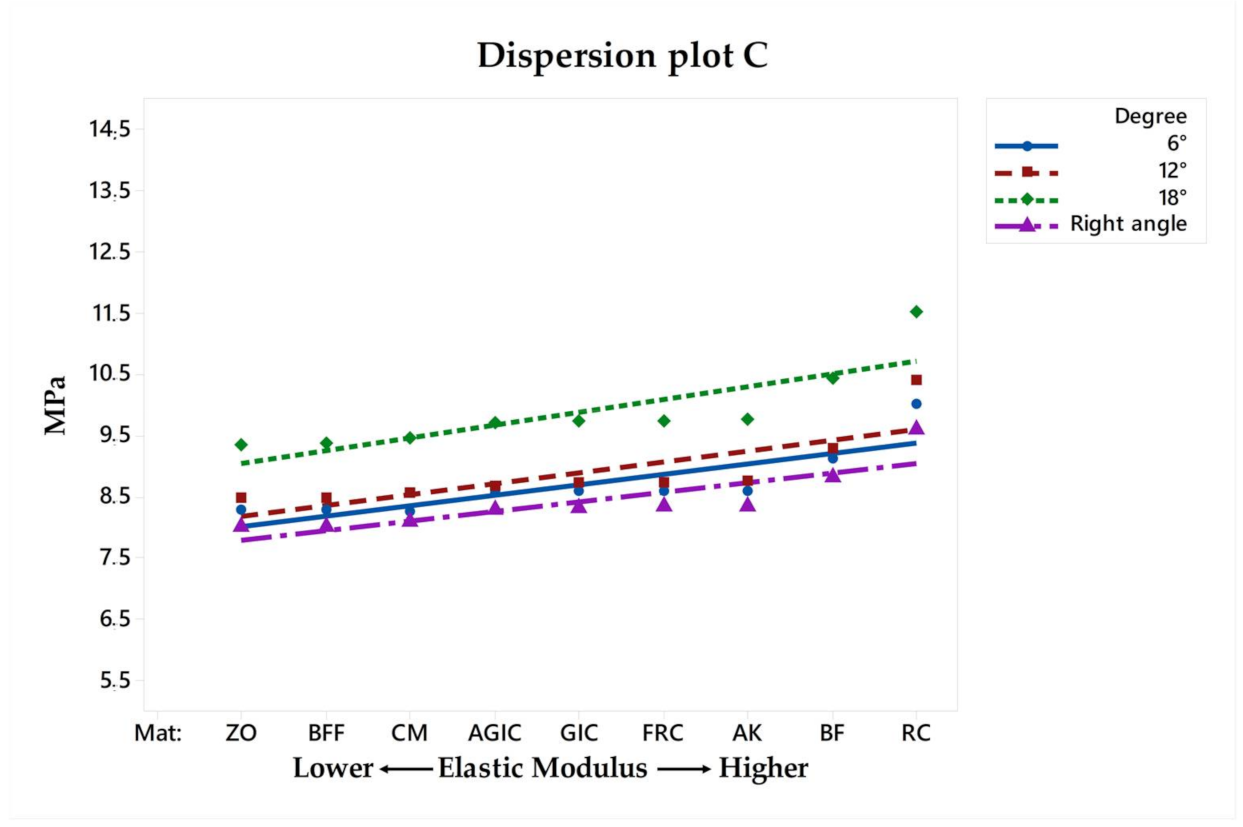Lithium Disilicate Ceramic Endocrown Biomechanical Response According to Different Pulp Chamber Extension Angles and Filling Materials
Abstract
1. Introduction
2. Materials and Methods
3. Results
4. Discussion
5. Conclusions
Author Contributions
Funding
Institutional Review Board Statement
Informed Consent Statement
Data Availability Statement
Conflicts of Interest
References
- Biacchi, G.R.; Basting, R.T. Comparison of fracture strength of endocrowns and glass fiber post-retained conventional crowns. Oper. Dent. 2012, 37, 130–136. [Google Scholar] [CrossRef] [PubMed]
- Topkara, C.; Keleş, A. Examining the adaptation of modified endocrowns prepared with CAD-CAM in maxillary and mandibular molars: A microcomputed tomography study. J. Prosthet. Dent. 2021, 13, S0022–3913. [Google Scholar] [CrossRef]
- Tribst, J.P.M.; Dal Piva, A.M.O.; de Jager, N.; Bottino, M.A.; de Kok, P.; Kleverlaan, C.J. Full-crown versus endocrown approach: A 3D-analysis of both restorations and the effect of ferrule and restoration material. J. Prosthodont. 2020, 28. [Google Scholar] [CrossRef] [PubMed]
- Al-Dabbagh, R.A. Survival and success of endocrowns: A systematic review and meta-analysis. J. Prosthet. Dent. 2021, 125, 415.e1–415.e9. [Google Scholar] [CrossRef]
- Fages, M.; Bennasar, B. The endocrown: A different type of all-ceramic reconstruction for molars. J. Can. Dent. Assoc. 2013, 79, d140. [Google Scholar] [PubMed]
- Dejak, B.; Młotkowski, A. A comparison of mvM stress of inlays, onlays and endocrowns made from various materials and their bonding with molars in a computer simulation of mastication—FEA. Dent. Mater. 2020, 36, 854–864. [Google Scholar] [CrossRef]
- Zhu, J.; Wang, D.; Rong, Q.; Qian, J.; Wang, X. Effect of central retainer shape and abduction angle during preparation of teeth on dentin and cement layer stress distributions in endocrown-restored mandibular molars. Dent. Mater. J. 2020, 21, 464–470. [Google Scholar] [CrossRef]
- de Kuijper, M.; Cune, M.S.; Tromp, Y.; Gresnigt, M.M.M. Cyclic loading and load to failure of lithium disilicate endocrowns: Influence of the restoration extension in the pulp chamber and the enamel outline. J. Mech. Behav. Biomed. Mater. 2020, 105, 103670. [Google Scholar] [CrossRef]
- Ghoul, W.E.; Özcan, M.; Tribst, J.P.M.; Salameh, Z. Fracture resistance, failure mode and stress concentration in a modified endocrown design. Biomater. Investig. Dent. 2020, 7, 110–119. [Google Scholar] [CrossRef]
- Eskitaşçioğlu, M.; Küçük, O.; Eskitaşçioğlu, G.; Eraslan, O.; Belli, S. The effect of different materials and techniques on stress distribution in CAD/CAM endocrowns. Strength Mater. 2020, 52, 812–819. [Google Scholar] [CrossRef]
- El Ghoul, W.; Özcan, M.; Silwadi, M.; Salameh, Z. Fracture resistance and failure modes of endocrowns manufactured with different CAD/CAM materials under axial and lateral loading. J. Esthet. Restor. Dent. 2019, 31, 378–387. [Google Scholar] [CrossRef]
- Sağlam, G.; Cengiz, S.; Karacaer, Ö. Marginal adaptation and fracture strength of endocrowns manufactured with different restorative materials: SEM and mechanical evaluation. Microsc. Res. Tech. 2021, 84, 284–290. [Google Scholar] [CrossRef] [PubMed]
- Elashmawy, Y.; Elshahawy, W.; Seddik, M.; Aboushelib, M. Influence of fatigue loading on fracture resistance of endodontically treated teeth restored with endocrowns. J. Prosthodont. Res. 2020, 9, 218–220. [Google Scholar] [CrossRef] [PubMed]
- Dogui, H.; Abdelmalek, F.; Amor, A.; Douki, N. Endocrown: An alternative approach for restoring endodontically treated molars with large coronal destruction. Case Rep. Dent. 2018, 30, 1581952. [Google Scholar] [CrossRef]
- Lin, J.; Lin, Z.; Zheng, Z. Effect of different restorative crown design and materials on stress distribution in endodontically treated molars: A finite element analysis study. BMC Oral Health 2020, 18, 226. [Google Scholar] [CrossRef] [PubMed]
- Darwish, H.A.; Morsi, T.S.; El Dimeery, A.G. Internal fit of lithium disilicate and resin nano-ceramic endocrowns with different preparation designs. Future Dent. J. 2017, 3, 67–72. [Google Scholar] [CrossRef]
- Haralur, S.B.; Alamrey, A.A.; Alshehri, S.A.; Alzahrani, D.S.; Alfarsi, M. Effect of different preparation designs and all ceramic materials on fracture strength of molar endocrowns. J. Appl. Biomater. Funct. Mater. 2020, 18, 2280800020947329. [Google Scholar] [CrossRef]
- Tribst, J.P.; Dal Piva, A.O.; Madruga, C.F.; Valera, M.C.; Bresciani, E.; Bottino, M.A.; de Melo, R.M. The impact of restorative material and ceramic thickness on CAD\CAM endocrowns. J. Clin. Exp. Dent. 2019, 1, e969–e977. [Google Scholar] [CrossRef]
- Seddik, T.; Derelioglu, S. Effect of endocrowns on fracture strength and microleakage of endodontically treated primary molar teeth. J. Adv. Oral Res. 2019, 10, 113–119. [Google Scholar] [CrossRef]
- Thomas, R.M.; Kelly, A.; Tagiyeva, N.; Kanagasingam, S. Comparing endocrown restorations on permanent molars and premolars: A systematic review and meta-analysis. Br. Dent. J. 2020, 14. [Google Scholar] [CrossRef]
- Menezes-Silva, R.; Espinoza, C.A.V.; Atta, M.T.; de Lima Navarro, M.F.; Ishikiriama, S.K.; Mondelli, R.F.L. Endocrown: A conservative approach. Braz. Dent. Sci. 2016, 19, 121–131. [Google Scholar] [CrossRef]
- Tribst, J.P.M.; Dal Piva, A.M.O.; Madruga, C.F.L.; Valera, M.C.; Borges, A.L.S.; Bresciani, E.; de Melo, R.M. Endocrown restorations: Influence of dental remnant and restorative material on stress distribution. Dent. Mater. 2018, 34, 1466–1473. [Google Scholar] [CrossRef] [PubMed]
- Ma, L.; Guess, P.C.; Zhang, Y. Load-bearing properties of minimal-invasive monolithic lithium disilicate and zirconia occlusal onlays: Finite element and theoretical analyses. Dent. Mater. 2013, 29, 742–751. [Google Scholar] [CrossRef] [PubMed]
- Tribst, J.P.M.; Dal Piva, A.M.d.O.; Lo Giudice, R.; Borges, A.L.S.; Bottino, M.A.; Epifania, E.; Ausiello, P. The influence of custom-milled framework design for an implant-supported full-arch fixed dental prosthesis: 3D-FEA study. Int. J. Environ. Res. Public Health 2020, 17, 4040. [Google Scholar] [CrossRef]
- Rees, J.S.; Jacobsen, P.H. Elastic modulus of the periodontal ligament. Biomaterials 1997, 18, 995–999. [Google Scholar] [CrossRef]
- Correia, A.; Andrade, M.R.; Tribst, J.; Borges, A.; Caneppele, T. Influence of bulk-fill restoration on polymerization shrinkage stress and marginal gap formation in class V restorations. Oper. Dent. 2020, 1, E207–E216. [Google Scholar] [CrossRef] [PubMed]
- Ausiello, P.; Ciaramella, S.; De Benedictis, A.; Lanzotti, A.; Tribst, J.P.M.; Watts, D.C. The use of different adhesive filling material and mass combinations to restore class II cavities under loading and shrinkage effects: A 3D-FEA. Comput. Methods Biomech. Biomed. Eng. 2020, 22, 1–11. [Google Scholar] [CrossRef]
- Pai, S.; Naik, N.; Patil, V.; Kaur, J.; Awasti, S.; Nayak, N. Evaluation and comparison of stress distribution in restored cervical lesions of mandibular premolars: Three-dimensional finite element analysis. J. Int. Soc. Prev. Community Dent. 2019, 4, 605–611. [Google Scholar] [CrossRef]
- Ausiello, P.P.; Ciaramella, S.; Lanzotti, A.; Ventre, M.; Borges, A.L.; Tribst, J.P.; Dal Piva, A.; Garcia-Godoy, F. Mechanical behavior of Class I cavities restored by different material combinations under loading and polymerization shrinkage stress. A 3D-FEA study. Am. J. Dent. 2019, 32, 55–60. [Google Scholar]
- Dikova, T.; Vasilev, T.; Hristova, V.; Panov, V. Finite element analysis in setting of fillings of V-shaped tooth defects made with glass-ionomer cement and flowable composite. Processes 2020, 8, 363. [Google Scholar] [CrossRef]
- Antunes, C., Jr.; Mercuri, E.G.F.; Franco, A.P.G.O.; Costa, M.; Karam, L.Z.; Kalinowski, H.J.; Gomes, O.M.M. Bulk fill flow resin contraction using 3D finite element model and calibration by Fiber Bragg Grating measurement. Comput. Methods Biomech. Biomed. Eng. 2020, 23, 1127–1137. [Google Scholar] [CrossRef]
- Srivastava, B.N.; Devi, N.; Gupta, N.; Singh, R. Comparative evaluation of various temperature changes on stress distribution in class II mesial-occlusal-distal preparation restored with different restorative materials: A finite element analysis. Int. J. Clin. Pediatr. Dent. 2018, 11, 167–170. [Google Scholar] [CrossRef]
- Tribst, J.P.M.; Borges, A.L.S.; Silva-Concílio, L.R.; Bottino, M.A.; Özcan, M. Effect of restorative material on mechanical response of provisional endocrowns: A 3D—FEA study. Materials 2021, 14, 649. [Google Scholar] [CrossRef]
- Ferrari, M.; Keeling, A.; Mandelli, F.; Lo Giudice, G.; Garcia-Godoy, F.; Joda, T. The ability of marginal detection using different intraoral scanning systems: A pilot randomized controlled trial. Am. J. Dent. 2018, 31, 272–276. [Google Scholar]
- Ghajghouj, O.; Taşar-Faruk, S. Evaluation of fracture resistance and microleakage of endocrowns with different intracoronal depths and restorative materials luted with various resin cements. Materials 2019, 12, 2528. [Google Scholar] [CrossRef]
- Belleflamme, M.M.; Geerts, S.O.; Louwette, M.M.; Grenade, C.F.; Vanheusden, A.J.; Mainjot, A.K. No post-no core approach to restore severely damaged posterior teeth: An up to 10-year retrospective study of documented endocrown cases. J. Dent. 2017, 63, 1–7. [Google Scholar] [CrossRef] [PubMed]
- da Fonseca, G.F.; Dal Piva, A.M.; Tribst, J.P.; Borges, A.L. Influence of restoration height and masticatory load orientation on ceramic endocrowns. J. Contemp. Dent. Pract. 2018, 19, 1052–1057. [Google Scholar] [CrossRef] [PubMed]
- Aktas, G.; Yerlikaya, H.; Akca, K. Mechanical failure of endocrowns manufactured with different ceramic materials: An in vitro biomechanical study. J. Prosthodont. 2018, 27, 340–346. [Google Scholar] [CrossRef] [PubMed]
- Pires, C.W.; Lenzi, T.L.; Soares, F.Z.M.; Rocha, R.O. Zinc oxide eugenol paste jeopardises the adhesive bonding to primary dentine. Eur. Arch. Paediatr. Dent. 2018, 19, 163–169. [Google Scholar] [CrossRef] [PubMed]
- Khosravani, M.R. Mechanical behavior of restorative dental composites under various loading conditions. J. Mech. Behav. Biomed. Mater. 2019, 93, 151–157. [Google Scholar] [CrossRef] [PubMed]
- Habib, A.N.A.; Waly, G.H. The degree of conversion and class II cavity microleakage of different bulk fill composites placed with different restorative techniques. Future Dent. J. 2018, 4, 231–238. [Google Scholar] [CrossRef]
- Giudice, R.L.; Famà, F. Health care and health service digital revolution. Int. J. Environ. Res. Public Health 2020, 17, 4913. [Google Scholar] [CrossRef] [PubMed]






| Abbreviation | Materials/Structures | Elastic Modulus (GPa) | Poisson Ratio | References |
|---|---|---|---|---|
| - | Lithium disilicate | 95 | 0.30 | [23] |
| - | Enamel Tissue | 70 | 0.30 | [23] |
| - | Dentin Tissue | 18 | 0.30 | [23] |
| - | Cancellous bone | 1.37 | 0.30 | [24] |
| - | Cortical bone | 13.7 | 0.30 | [24] |
| - | Periodontal Ligament | 0.05 | 0.45 | [25] |
| RC | Resin composite | 13.45 | 0.17 | [26] |
| BF | Bulk-fill resin composite | 13.46 | 0.18 | [26] |
| AK | Alkasite | 13.00 | 0.30 | [28] |
| FRC | Flowable resin composite | 8.0 | 0.20 | [27] |
| GIC | Glass Ionomer Cement | 8.0 | 0.25 | [29] |
| AGIC | Autocured resin-reinforcedGlass ionomer cement | 8.32 | 0.27 | [30] |
| CM | Resin Cement | 8.6 | 0.18 | [23] |
| BFF | Bulk-fill flowable resin composite | 3.70 | 0.30 | [31] |
| ZO | Zinc oxide cement | 1.35 | 0.30 | [32] |
Publisher’s Note: MDPI stays neutral with regard to jurisdictional claims in published maps and institutional affiliations. |
© 2021 by the authors. Licensee MDPI, Basel, Switzerland. This article is an open access article distributed under the terms and conditions of the Creative Commons Attribution (CC BY) license (http://creativecommons.org/licenses/by/4.0/).
Share and Cite
Tribst, J.P.M.; Lo Giudice, R.; dos Santos, A.F.C.; Borges, A.L.S.; Silva-Concílio, L.R.; Amaral, M.; Lo Giudice, G. Lithium Disilicate Ceramic Endocrown Biomechanical Response According to Different Pulp Chamber Extension Angles and Filling Materials. Materials 2021, 14, 1307. https://doi.org/10.3390/ma14051307
Tribst JPM, Lo Giudice R, dos Santos AFC, Borges ALS, Silva-Concílio LR, Amaral M, Lo Giudice G. Lithium Disilicate Ceramic Endocrown Biomechanical Response According to Different Pulp Chamber Extension Angles and Filling Materials. Materials. 2021; 14(5):1307. https://doi.org/10.3390/ma14051307
Chicago/Turabian StyleTribst, João Paulo Mendes, Roberto Lo Giudice, Alison Flavio Campos dos Santos, Alexandre Luiz Souto Borges, Laís Regiane Silva-Concílio, Marina Amaral, and Giuseppe Lo Giudice. 2021. "Lithium Disilicate Ceramic Endocrown Biomechanical Response According to Different Pulp Chamber Extension Angles and Filling Materials" Materials 14, no. 5: 1307. https://doi.org/10.3390/ma14051307
APA StyleTribst, J. P. M., Lo Giudice, R., dos Santos, A. F. C., Borges, A. L. S., Silva-Concílio, L. R., Amaral, M., & Lo Giudice, G. (2021). Lithium Disilicate Ceramic Endocrown Biomechanical Response According to Different Pulp Chamber Extension Angles and Filling Materials. Materials, 14(5), 1307. https://doi.org/10.3390/ma14051307









